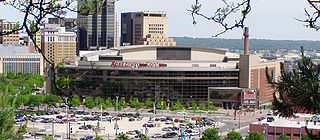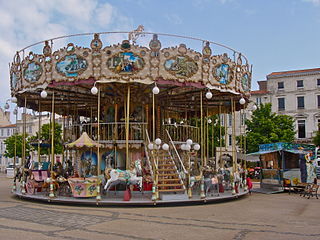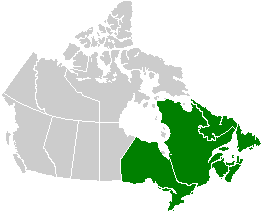
An ice carousel is a circular piece of ice made to spin like a carousel within a larger body of water, often a frozen lake. It is a man-made phenomenon, made by cutting the floating ice sheet, unlike the natural rotating ice circles.

An ice carousel is a circular piece of ice made to spin like a carousel within a larger body of water, often a frozen lake. It is a man-made phenomenon, made by cutting the floating ice sheet, unlike the natural rotating ice circles.
In 2017, Janne Käpylehto carved one in Lohja, in Finland. [1]
Two men created one in Burntside Lake, near Ely, Minnesota, in 2018. [2]
An ice carousel created in Little Falls, Minnesota, in early 2019 was dubbed the largest in the world. [3]
In December 2019, on a lake in Clerval, Abitibi, Québec, Canada, a team constructed an ice carousel with a diameter of 209.7 m (688 ft 0 in) and an area of 34,307 m2 (369,280 sq ft), surpassing the prior record of 155 ft (47 m) set in the United States. The feat was recognized by the World Ice Carousel Association, which keeps track of records. [4]
An even larger ice carousel was cut into Lake Lappajärvi in Finland by Janne Käpylehto's team in February 2023. The carousel has a diameter of 516 m (1,692 ft 11 in). [5]
In April 2023, Volunteers in Madawaska, Maine, United States of America created an even larger ice carousel totaling 1,776 feet in diameter. [6]

A glacier is a persistent body of dense ice that is constantly moving under its own weight. A glacier forms where the accumulation of snow exceeds its ablation over many years, often centuries. It acquires distinguishing features, such as crevasses and seracs, as it slowly flows and deforms under stresses induced by its weight. As it moves, it abrades rock and debris from its substrate to create landforms such as cirques, moraines, or fjords. Although a glacier may flow into a body of water, it forms only on land and is distinct from the much thinner sea ice and lake ice that form on the surface of bodies of water.

Lake Superior is the largest freshwater lake in the world by surface area and the third-largest freshwater lake by volume, holding 10% of the world's surface fresh water. Located in central North America, it is the northernmost and westernmost of the Great Lakes of North America, straddling the Canada–United States border with the Canadian province of Ontario to the north and east and the U.S. states of Minnesota to the west and Michigan and Wisconsin to the south. It drains into Lake Huron via St. Marys River, then through the lower Great Lakes to the St. Lawrence River and ultimately the Atlantic Ocean.

Smelts are a family of small fish, the Osmeridae, found in the North Atlantic and North Pacific oceans, as well as rivers, streams and lakes in Europe, North America and Northeast Asia. They are also known as freshwater smelts or typical smelts to distinguish them from the related Argentinidae, Bathylagidae, and Retropinnidae.

Ice skates are metal blades attached underfoot and used to propel the bearer across a sheet of ice while ice skating.

Finland attracted over 6.8 million foreign tourists in 2018, with 53 percent coming from other European Union states. In 2017, the value added by tourism was about 4.6 billion euros, or 2.6% of the Finnish GDP, providing approximately 140,200 jobs.

Xcel Energy Center is a multipurpose arena in Saint Paul, Minnesota, United States. Completed in 2000, it is named for its locally based corporate sponsor Xcel Energy. With an official capacity of 17,954, the arena has four spectator levels: one suite level and three for general seating. The building is home to the NHL's Minnesota Wild and Minnesota of the PWHL.

A carousel or carrousel, merry-go-round (international), or roundabout is a type of amusement ride consisting of a rotating circular platform with seats for riders. The "seats" are traditionally in the form of rows of wooden horses or other animals mounted on posts, many of which are moved up and down by gears to simulate galloping, to the accompaniment of looped circus music.

Ice fishing is the practice of catching fish with lines and fish hooks or spears through an opening in the ice on a frozen body of water. Ice fishers may fish in the open or in heated enclosures, some with bunks and amenities.

Lake Peipus is the largest trans-boundary lake in Europe, lying on the international border between Estonia and Russia.

Moosehead Lake is a deep, coldwater lake located in Piscataquis County in Northwestern Maine. It is the largest lake in Maine, second-largest lake in New England, and the largest mountain lake in the eastern United States. Situated in the mostly undeveloped Longfellow Mountains, the lake is the source of the Kennebec River. Several rural Townships border the lake. Greenville is by far the largest town on the lake, with a small downtown area that has banks, shops, and restaurants. There are over 80 islands in the lake, the largest being Sugar Island and Deer Island to the west being the second largest.

An ice house, or icehouse, is a building used to store ice throughout the year, commonly used prior to the invention of the refrigerator. Some were underground chambers, usually man-made, close to natural sources of winter ice such as freshwater lakes, but many were buildings with various types of insulation.

A glacial erratic is a glacially deposited rock differing from the type of rock native to the area in which it rests. Erratics, which take their name from the Latin word errare, are carried by glacial ice, often over distances of hundreds of kilometres. Erratics can range in size from pebbles to large boulders such as Big Rock in Alberta.

An ice rink is a frozen body of water and/or an artificial sheet of ice where people can ice skate or play winter sports. Ice rinks are also used for exhibitions, contests and ice shows. The growth and increasing popularity of ice skating during the 1800s marked a rise in the deliberate construction of ice rinks in numerous areas of the world.

A snowman is an anthropomorphic snow sculpture of a man often built in regions with sufficient snowfall and is a common winter tradition. In many places, typical snowmen consist of three large snowballs of different sizes with some additional accoutrements for facial and other features. Due to the sculptability of snow, there is also a wide variety of other styles. Common accessories include branches for arms and a smiley face made of stones, with a carrot used for a nose. Clothing, such as a hat or scarf, may be included.

Ice discs, ice circles, ice pans, ice pancakes or ice crepes are a very rare natural phenomenon that occurs in slow moving water in cold climates. They are thin circular slabs of ice that rotate slowly on a body of water's surface.

The volcanism of Eastern Canada includes the hundreds of volcanic areas and extensive lava formations in Eastern Canada. The region's different volcano and lava types originate from different tectonic settings and types of volcanic eruptions, ranging from passive lava eruptions to violent explosive eruptions. Eastern Canada has very large volumes of magmatic rock called large igneous provinces. They are represented by deep-level plumbing systems consisting of giant dike swarms, sill provinces and layered intrusions. The most capable large igneous provinces in Eastern Canada are Archean age greenstone belts containing a rare volcanic rock called komatiite.

The Minnesota Duluth Bulldogs women's ice hockey team plays for the University of Minnesota Duluth at the AMSOIL Arena in Duluth, Minnesota. The team is a member of the Western Collegiate Hockey Association (WCHA) and competes in the National Collegiate Athletic Association (NCAA) in the Division I tier. The Bulldogs have won five NCAA Championships.
NCAA Division III women's ice hockey is a college ice hockey competition governed by the National Collegiate Athletic Association (NCAA) as part of the NCAA Division III. Sixty-seven teams competed in NCAA Division III women's hockey across eight conferences in the 2023–24 season.

The geology of Ontario is the study of rock formations in the most populated province in Canada- it is home to some of the oldest rock on Earth. The geology in Ontario consists of ancient Precambrian igneous and metamorphic rock which sits under younger, sedimentary rocks and soils.